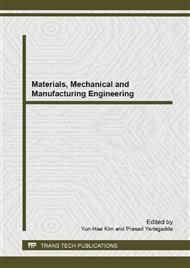p.104
p.110
p.114
p.118
p.122
p.130
p.134
p.138
p.142
Microstructure Evolution of Hypereutectic Al-Si Alloy in Semi-Solid Compression Deformation
Abstract:
The semi-solid microstructure evolution of hypereutectic Al-20Si-3Fe-1Mn-4Cu-1Mg alloy was studied by unidirectional compression deformation experiment, at a range of deformation temperature of 833K~873K and a range of strain rate of 0.1s-1~0.001s-1. The results showed that the microstructure of the reheating alloy was more spherical and fine than the microstructure of as-cast, the alloy was a positive strain rate sensitive material that the flow stress was decreased with increasing in deformation temperature and it was increased with increasing in strain rate. The mechanical properties of the alloy were hardly improved when the deformation temperature was too high to fracture the thick phase of the alloy.The lower strain rate was not only reducing the productivity but also reducing the plastic deformation. The microstructure of the alloy which the thick phase was broken fundamentally and the grain became further refinement can be obtained at 833K~853K, and at 0.1s-1~0.01s-1.It can be done that reducing the plastic deformation resistance and strengthening the fabrication procedure of the alloy.
Info:
Periodical:
Pages:
122-129
Citation:
Online since:
November 2013
Authors:
Price:
Сopyright:
© 2014 Trans Tech Publications Ltd. All Rights Reserved
Share:
Citation:


